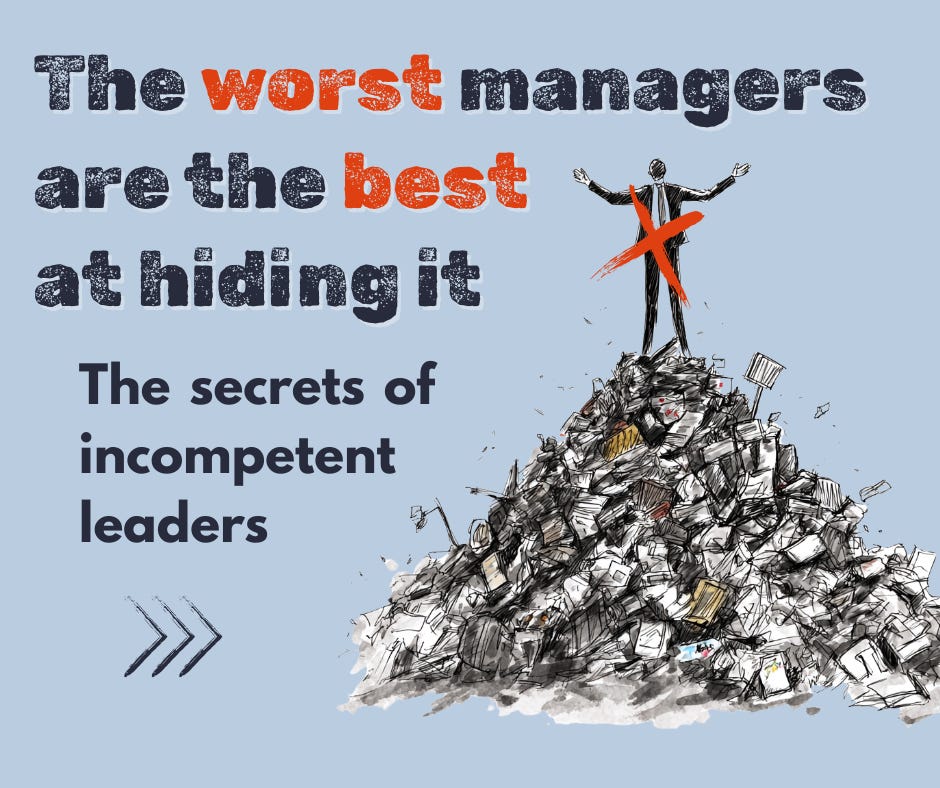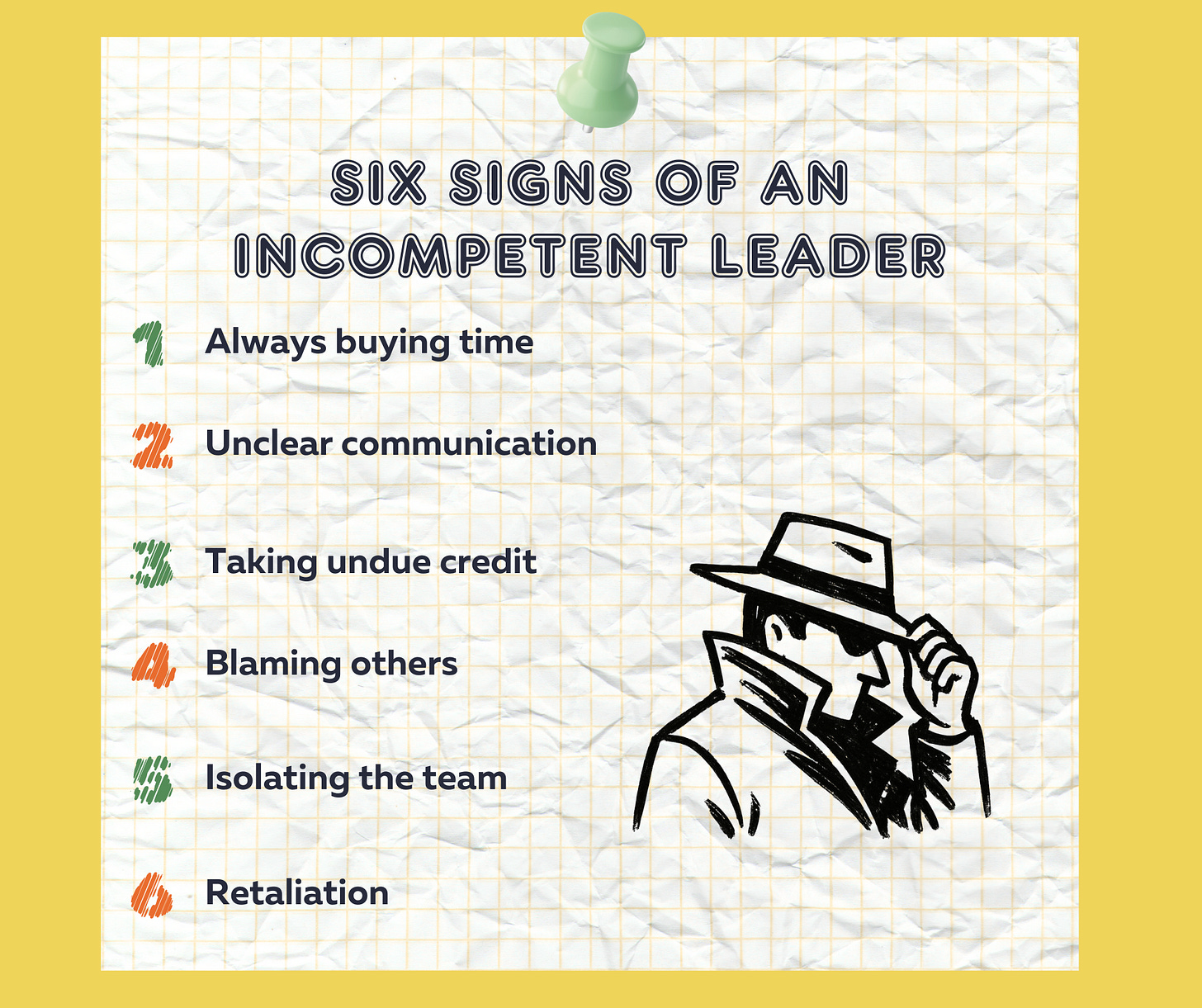The Worst Managers Are the Best at Hiding It
Exposing the secrets of incompetent leaders
Some of the worst managers have perfected the art of hiding their incompetence. They have a dysfunctional relationship with work. They feel the world owes them a good job — that they should be able to hold a well-paid, important position without adding value or putting effort in. Their primary skill? Making themselves look good to their superiors.
Left in place, incompetent leaders will:
Push out your best performers
Destroy trust and psychological safety so no one take risks
Waste huge amounts of time and runway on vanity and re-org projects with no chance of success
Create a “yes person” culture where critical thinking and collaboration stops
Incompetent leaders will undo all your work to empower brilliant people and exceptional teams. So more than any post, I ask you to share this. I want to expose and remove incompetent leaders from positions of power, where they harm everyone.
Most of us have worked with them, some of us for them. But how do they operate? How do they climb the ladder? What’s their playbook?
And, perhaps more importantly, how do we spot them, avoid hiring them, and deal with them?
They can’t excel, they can’t solve problems, they can’t have impact. They don’t know how to.
The Incompetent Leader
Incompetent leaders are completely lacking in the skills and ability necessary to fulfil their role. Once you understand this, their behaviour makes sense. They can’t excel, they can’t solve problems, they can’t have impact. They don’t know how to. Many are now so deep into this that there is no recovery — they have been doing this their whole career.
Notice this is different from just “bad” managers. All incompetent managers are bad, but most bad managers aren’t incompetent.
Their purpose is to survive long enough in this position to be able to use the success of the company (in spite of them) to fail upwards to their next role. This is the cycle.
They will point to 3x revenue during their tenure, a Series B closed at a 10x valuation.
They will rewrite history.
Their LinkedIn will be full of “acquired by X”, “sold to X”.
When you dig in, you will find many of these were at down valuations or happened before or after they joined.
Incompetent leaders wield their titles like an axe. They want compliance, submission, respect. They do nothing to earn it, they don’t build trust — they demand it.
They seriously harm team performance. They reduce productivity, drive away talented individuals, and retain those who remain silent and tolerate dysfunction.
Leaders must multiply, not divide. Removing incompetent managers swiftly prevents the spread of their toxic impact.
The Incompetent Leader’s Playbook
How do incompetent leaders get into important positions? How do they climb the ladder? The playbook is very simple.
They join a company already doing well
Buy time until they can’t any longer,
Fail upwards, claiming the success (in spite of them) as their own.
I first read about this idea in Shreyas Doshi’s Twitter posts on the subject; it’s worth the read!
Six Signs of an Incompetent Leader
There is no excuse for incompetence in high level positions, especially executives. They are at the top of the ladder, you cannot be bad at your job at the top of the game! Yet often, they are given more benefit of the doubt than junior hires.
There is some ramp up needed for new promotions, but these people aren’t bad — they are good at most aspects and are learning others. They don’t exhibit these traits.
Here’s how you can spot incompetent leaders early.
1. Always buying time
They never solve problems directly. Instead, they stall. There are four main things they like to do:
Make new hires
Introduce new process
Blame someone else
Reorganise the team
They’ll claim the need for new hires and won’t work on the problem until those hires are in place. New hires can easily take three months to recruit, and six months or more to get up to speed — buying nine or more months of time.
They also love introducing new processes. They will constantly add and change processes pulled from blog posts and books. They won’t really know how to implement them — they will have barely even read the source. If you ask detailed questions, you’ll see it’s all surface-level. They will be opinionated, but quick to delegate execution.
When anything fails to get results, they will blame someone or something (see later) and pick another. You can buy three months to roll it out, and another three to see results. It’s very effective. It also tends to land well in executive and board meetings.
Once process and hiring have been milked, it’s time for a reorg! That’s another six to 12 months bought.
2. Unclear communication
Incompetent leaders thrive on unclear communication, key traits are:
Speaking at length instead of clearly
Using jargon
Having prepared speeches, reports or presentations to jump into
When asked to give an update, they will speak at length and say very little, using a lot of words. Many people accept the length of speech as evidence of work (often not consciously). They will use big words and jargon. They don’t want you to follow and understand; they want you to wish for it all to be over, and to move on.
But don’t. After they’ve finished rambling, try to summarise what they said — you will struggle. Repeat it back to them and ensure you have clarity. If something doesn’t make sense, say so. Do not let them blow past it.
They will use the uncomfortable nature of this questioning in a group meeting to their advantage. So, if it heads that way, make a note and follow up one-to-one.
They will not answer direct questions. Like a politician, they’ll drop into a prepared speech on a loosely related topic. They may pull out a slide deck, this makes them look competent and on top of things. Is the deck even relevant? It’s highly unlikely they even wrote it, though they will claim any credit.
Using reports and presentations isn’t bad in itself — but was it relevant? Was it useful? Again, try to summarise it.
After they’ve finished rambling, try to summarise what they said — you will struggle. Repeat it back to them and ensure you have clarity.
3. Taking undue credit
They will:
Take credit for wins, even those of other teams.
Blame others for failure.
Mislead others about their past success.
They quickly claim credit for successes, especially those due to external factors or team efforts, and will rarely acknowledge the team’s role. They will attach their name as a stakeholder to anything they think might be a success. I have even seen them try to put their name on work of other teams.
Wins are the currency of many companies. Gather a few and you’ll be forgiven for future failures. They know this, and have no shame in stealing them.
Ask yourself: where would we be if we had a great hire in this position? Incompetent leaders thrive when compared to having no one in the role.
Their LinkedIn profile probably lists many company exits, fundraises and massive valuation increases. This is often, at best, technically correct and, at worst, dishonest. But even if it’s true, how much effort did they contribute? How much better was the company for having them there? Their last company exiting is not a direct reflection on them.
At interview, question them in depth to find their true contributions.
Do they speak positively of their team?
Do they highlight other individuals?
Do they ascribe everything to themselves?
I have put together some key questions for assessing leadership in an interview here!
4. Blaming: throwing team members under the bus.
When things go wrong, they will blame and undermine anyone they can.
I’ve witnessed them many times in exec meetings throwing their own team under the bus. No! You are responsible for your team; you take that responsibility here, with us. Blaming someone in their team in front of the other execs is a big red flag.
Blaming is not the same as being able to have actual performance discussions — the difference should be apparent.
The closest they will get to taking responsibility is, “John screwed up, but look, I’m the leader so I take responsibility.” They pretend to take responsibility but make sure everyone knows who is at “fault.”
Another trick is to blame while appearing reluctant to do so: “Sarah messed up on this, but I’m working closely with them on it now.”
I’ve even seen them blame a team member for doing something they themselves instructed, that the team member protested against. And when it predictably failed… they were blamed.
5. Isolation & controlling information flow
Controlling information flow is key for them. They:
Demand everything goes through them
Discourage open communication with other departments
Ensure only they control the narrative with the exec team and board
They set things up so their teams can’t run without them — the opposite of what brilliant leaders do, which is trust and empower their teams. Since they can’t be essential through competence, they make themselves essential by controlling information flow.
They insist everything flows solely through them so they remain critical to every conversation and narrative. Projects can’t move forward without them, and to an outside observer, they appear essential.
They discourage open communication with other departments. They don’t want you gossiping or letting news of their incompetence and toxicity spread. When it inevitably does, they lash out.
They control the narrative with the exec team and board. They resist other team members entering these channels so they can maintain control over the flow of information with key people.
6. Retaliation
When incompetent leaders risk exposure, retaliation is common. If a team member speaks up — whether directly to their manager’s superior or to colleagues — the incompetent leader acts decisively:
Threatening job security
Gaslighting concerns as disloyalty
Publicly discrediting, e.g. by creating false narratives about their performance
This aggressive behaviour aims to crush dissent and maintain control. They need to shut it down and discourage any further whistleblowers.
Sometimes this is very underhanded. They may start subtly raising issues about this person in all their conversations with others. They will create false narratives, claiming the whistleblower said something about others, damaging their relationships. To the whistleblower’s face, they may do the same, claiming other people have a problem with them. This leads to false conflict and isolation.
Like a lawyer trying to remove an important witness, they will attempt to destroy the threat by attacking their credibility and reputation so that, no matter what they say in future, they can’t do damage.
You need to protect those brave enough to raise concerns. Do not immediately run to the leader and say, “Mike said this about you.” Retaliation will be swift. Investigate properly and watch closely for any signs of retaliation.
Closing thoughts
I want you to help your teams be exceptional. I want you to empower your people to be brilliant. Incompetent leaders aren’t just a thorn in the side of this — they are a bull in your china shop. Trust is fragile, psychological safety is fragile.
If they just made your team ineffective, that would be one (terrible) thing. But they also destroy strategy. They damage your business. At a startup, this is fatal. Nine to 12 months of lost runway can be game over.
I want this article to be something that helps you deal with incompetent leaders — something you can send to your manager to help them understand the problem.
So please, share it with them.
I’ll be following up this post with how to spot incompetent leaders in hiring, and how to deal with them if they’re already here. Subscribe to see this when it lands.
And finally, let me know — what have I missed? Where am I wrong?
Let me know your thoughts in the comments. I’ll update this post over time.






> All incompetent managers are bad, but most bad managers aren’t incompetent.
What do you see as the difference? Does bad include neglectful, which isn't necessarily incompetent?